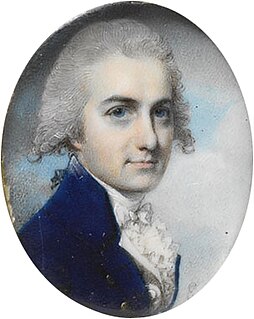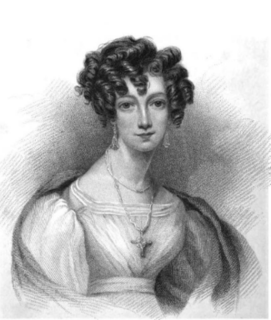Biography
Lens, the son of mezzotint engraver Bernard Lens II, was born in London in 1682 and in 1698 became an apprentice to an artist known as Sturt, quite likely his father's partner John Sturt (1658–1730). [1] [2] Sturt was a member of the Company of Goldsmiths, but the membership was merely a license to work within the City of London, not an indicator of his actual trade. [2]
In 1704 Lens joined the newly established Rose and Crown Club, an art society frequented by William Hogarth and George Vertue. [1] Lens established himself as a portrait miniaturist, and in 1707 became the first British artist to replace vellum, the traditional medium of miniatures, with ivory. [1] The difficult skill of painting watercolours on ivory was invented in Venice by Rosalba Carriera around 1700 and quickly spread over Europe. [1] The style of Lens was close to that of Carriera, although Lens conservatively employed pencil sketches and heavier paints that reduced translucency of glazes over the ivory substrate. [1] Dudley Heath and Marjorie Wieseman noted the contrast between the translucent, lightweight appearance of skin tones with solid, oil–like [3] draperies and backgrounds. [1] [3] In line with the fashion of his period Lens, according to Heath, "seems to be partial to a very crude light blue in the costumes", inferior to the blues of older masters. [3]
Bernard Lens III and his wife Katherine (née Woods) had at least three sons, among them Bernard Lens IV. [1] All [1] — though according to Horace Walpole's Catalogue of Engravers only two of the three [4] — became prolific draftsmen (Walpole: "ingenious painters in miniature") [4] but did not leave a significant legacy; attribution of their artwork is problematic. [1] One of these sons, miniaturist Peter Paul Lens (1714–1750), has painted the portrait of his father that is conserved in the Victoria and Albert Museum. [5] Another son, Andrew Benjamin Lens, born around 1713, also was a miniaturist. [6]
His main competitor was Christian Friedrich Zincke, who worked in enamel. [7] Horace Walpole called Bernard Lens III "the incomparable painter in watercolours" [8] and lamented that his copies of great masters "had all the merits of the originals except what they deserved too: duration." [8] Dudley Heath, on the contrary, called Lens "hard and unappealing", inferior to Laurence Crosse. [3]
The "Entire and Elaborate Works of Mr. Bernard Lens" were auctioned by Christopher Cock on 11–12 February 1737. [9]
Events from the year 1757 in art.

A portrait miniature is a miniature portrait painting, usually executed in gouache, watercolor, or enamel. Portrait miniatures developed out of the techniques of the miniatures in illuminated manuscripts, and were popular among 16th-century elites, mainly in England and France, and spread across the rest of Europe from the middle of the 18th century, remaining highly popular until the development of daguerreotypes and photography in the mid-19th century. They were usually intimate gifts given within the family, or by hopeful males in courtship, but some rulers, such as James I of England, gave large numbers as diplomatic or political gifts. They were especially likely to be painted when a family member was going to be absent for significant periods, whether a husband or son going to war or emigrating, or a daughter getting married.

John Smart, was an English painter of portrait miniatures. He was a contemporary of Richard Cosway, George Engleheart, William Wood and Richard Crosse.

Rosalba Carriera was a Venetian Rococo painter. In her younger years, she specialized in portrait miniatures. It is for this that she was able to build a career in portraiture. Carriera would later become known for her pastel work, a medium appealing to Rococo styles for its soft edges and flattering surfaces. She is remembered as one of the most successful women artists of any era.

George Engleheart (1750–1829) was one of the greatest English painters of portrait miniatures, and a contemporary of Richard Cosway, John Smart, William Wood, and Richard Crosse.

Levina Teerlinc was a Flemish Renaissance miniaturist who served as a painter to the English court of Henry VIII, Edward VI, Mary I and Elizabeth I. She was the most important miniaturist at the English court between Hans Holbein the Younger and Nicholas Hilliard. Her father, Simon Bening was a renowned book illuminator and miniature painter of the Ghent-Bruges school and probably trained her as a manuscript painter. She may have worked in her father's workshop before her marriage.

Plumbago drawings are graphite drawings from the 17th and 18th centuries. There was a group of artists whose work in plumbago is remarkable for their portraits drawn with finely pointed pieces of graphite and on vellum. Initially these works were often prepared as the basis of an engraving. As time went by they would be produced as works in their own right.
Events from the year 1740 in art.
Events from the year 1762 in art.

Charles Hayter was an English painter.

Jeremiah Meyer was an 18th-century English miniature painter. He was Painter in Miniatures to Queen Charlotte, Painter in Enamels to King George III and was one of the founder members of the Royal Academy.

Richard Crosse (1742–1810) was a leading English painter of portrait miniatures. He was a contemporary of John Smart, George Engleheart, Richard Cosway and William Wood.

Gervase Spencer (c.1715–1763), was an English miniaturist. Originally a footman to a "Dr W," Spencer taught himself the art of painting in watercolour on ivory, and was encouraged by his employer. Since enamels were in vogue at the time, he also mastered the complexities of this process. Spencer's prodigious output is divided almost equally between enamels and ivory. Spencer's early work closely resembles that of Jean-André Rouquet and may well have been influenced by him. Spencer trained Henry Spicer to continue the tradition and art of miniatures on enamel and ivory.

Bernard Lens II (1659–1725) was an English engraver, pioneer of mezzotint technique, and publisher.

Samuel Shelley (1750/56–1808) was an English miniaturist and watercolour painter.

Louis-Marie Autissier, was a French-born Belgian portrait miniature painter. According to Marjorie E. Wieseman, curator of European painting, at the Cincinnati Art Museum, "Autissier's success as a miniaturist was in large measure due to his talent as a colourist and his meticulous detailing of costumes and accessory." He is considered the founder of the Belgian school of miniature painting in the nineteenth century. Among his most accomplished pupils and followers were Alexandre Delatour (1780—1858), Louis Henry Fontenay (1800—1852), and Dominique Ducaju (1802—1867). His works are in the collections of the Cincinnati Art Museum, the Nationalmuseum and the Royal Collection.

John William Wright was an English genre and portrait watercolour painter, and illustrator.
Cornelia Ellis Hildebrandt was an American artist particularly known for her portrait miniatures. One of the last surviving figures from the revival of miniature painting in America at the turn of the 20th century, she lectured extensively on the genre in her later years.

Maria Ann Chalon was a British painter of miniatures. She was Portrait Paintress to his Royal Highness, the Duke of York, and is considered one of the most talented and successful female British miniaturists of the early nineteenth century.
Catherine Rachel da Costa (1679–1756), née Mendes, was an English miniaturist. She grew up in London and studied painting under Bernard Lens III. Most of her surviving portraits are of family and friends, and there is also a picture of Mary Queen of Scots. Da Costa was the first female Anglo-Jewish artist of note. In her personal life, she married Moses da Costa and had six children.
















